The HP S700 And S700 Pro SSD Review
by Billy Tallis on September 7, 2017 9:00 AM ESTAnandTech Storage Bench - Heavy
Our Heavy storage benchmark is proportionally more write-heavy than The Destroyer, but much shorter overall. The total writes in the Heavy test aren't enough to fill the drive, so performance never drops down to steady state. This test is far more representative of a power user's day to day usage, and is heavily influenced by the drive's peak performance. The Heavy workload test details can be found here. This test is run twice, once on a freshly erased drive and once after filling the drive with sequential writes.
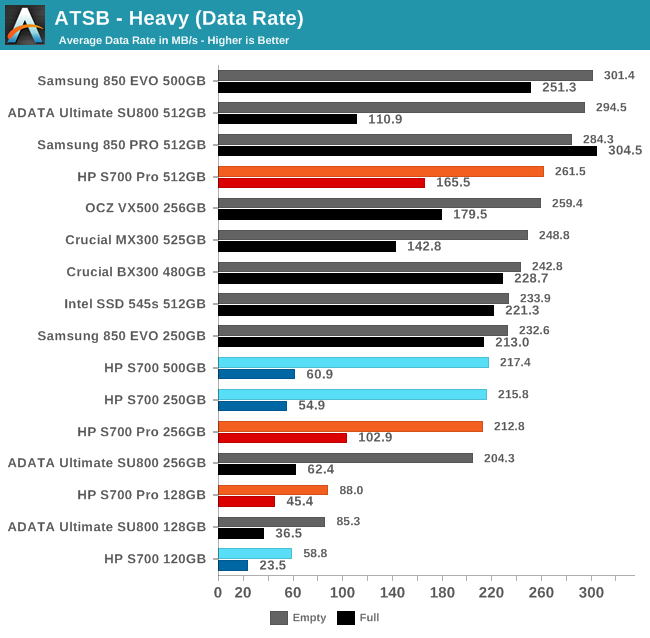
The different classes of SSD can be identified by how much slower they perform when full compared to their fresh out of the box state. On the Heavy test, the HP S700 and S700 Pro tend to deliver average data rates that are close to the mid-range and high-end SATA SSDs when the test is run on an empty drive. When the test is run on a full drive, the best SSDs are only slowed by a few percent, while the DRAMless HP S700's average data rate can drop to a quarter of its other score. The S700 Pro doesn't suffer as badly, and its full-drive performance penalty is much less severe than what the ADATA SU800 suffers from, even when the peak performance of the S700 Pro is lower.
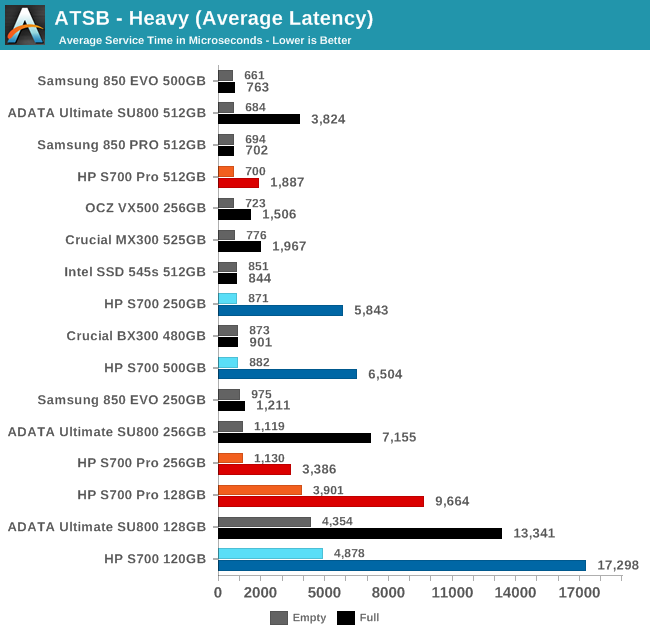

The average and 99th percentile latency scores make the full vs. empty performance differences even clearer. The S700 Pro's average latency is two to three times higher when full, and the S700's average latency can be over seven times higher when full. The differences are larger when considering 99th percentile latencies. The worst of these latency scores are well above the seek times of a mechanical hard drive, though overall performance is still far better than a hard drive can offer on a test with such a high average queue depth (by client workload standards). The 120GB HP S700 is the only HP drive that shows particularly poor latency compared to the competitors when the test is run on an empty drive.
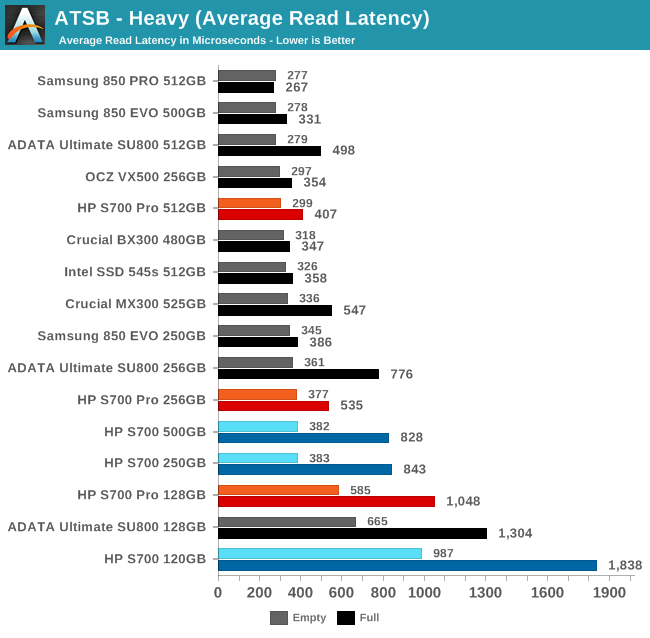
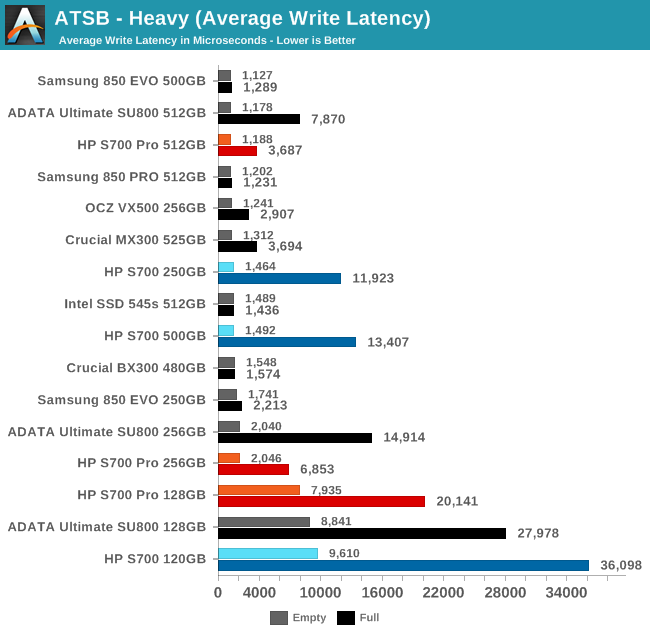
Average read latencies don't vary much among SATA drives when the Heavy test is run on an empty drive; only the 120GB-class drives are significantly slower than par. When the test is run on a full drive, read latencies are merely doubled in even the most strongly affected drives. On the write side, the 120GB-class drives have much higher latency than the rest even when the test is run on an empty drive. The HPs and the ADATA SU800 are the drives that show the most severe impact from the drive being full, with the HP S700 being affected the most and the S700 Pro being less affected than the ADATA SU800.
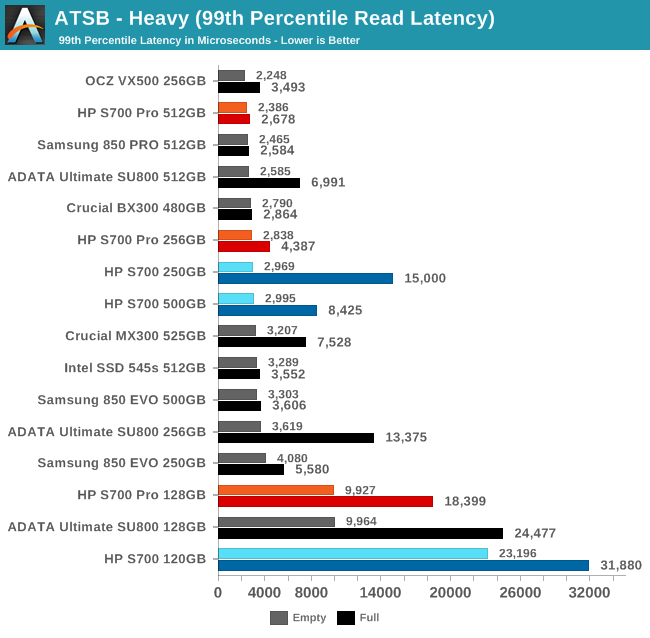
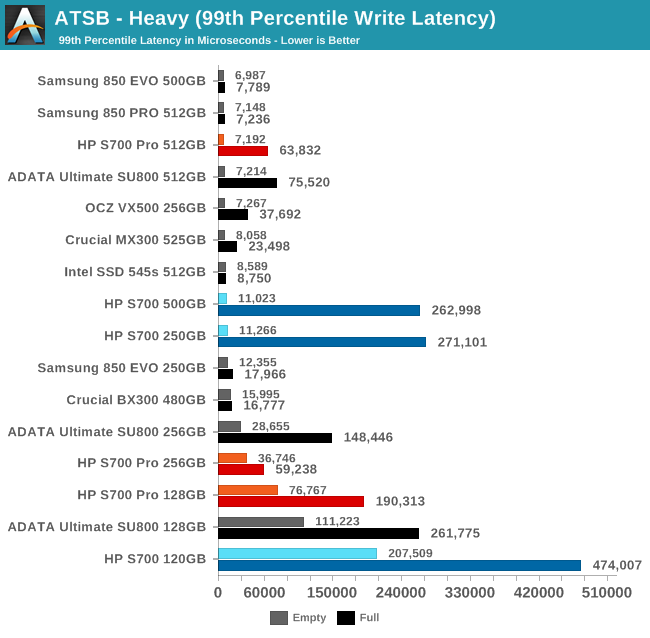
The rankings for 99th percentile read and write latencies are similar to the average latency rankings. The 120/128GB drives are substantially slower than the larger drives, where even the DRAMless HP S700 offers reasonable performance provided it isn't full.
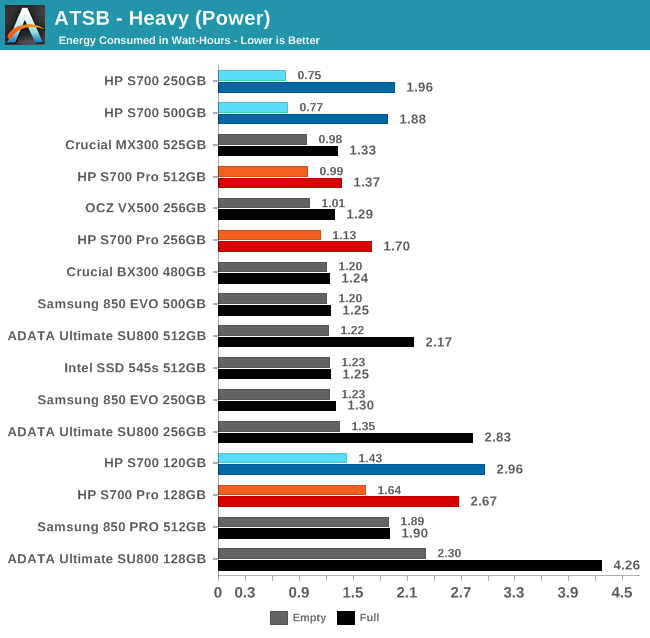
The larger two capacities of the HP S700 take the lead for energy efficiency when the Heavy test is run on an empty drive, and even when full they don't use significantly more energy than the Samsung 850 PRO. The 512GB HP S700 Pro also scores quite well in both scenarios, with energy usage only slightly higher than the Crucial MX300. In all cases, both HP models offer clearly better energy efficiency than the ADATA SU800.










54 Comments
View All Comments
ddriver - Thursday, September 7, 2017 - link
Why is it "Pro"? Performance - nope, endurance - nope, warranty - nope, sounds better - nailed it.HP's brand new Pro bested by Samsung's ancient Evo...
MajGenRelativity - Thursday, September 7, 2017 - link
It's better than the 700 non-Pro, so it warrants that in relation to its other counterpart.mooninite - Thursday, September 7, 2017 - link
You nailed it. Unfortunately HP will sell units because 1) they'll ship them in their own systems they sell and 2) they have blindly loyal customers.MajGenRelativity - Thursday, September 7, 2017 - link
I assume that's why HP went to the trouble of making an SSD? :Psyxbit - Thursday, September 7, 2017 - link
Making? They're not making anything here. They're repackaging another company's engineering efforts.Samus - Thursday, September 7, 2017 - link
The only blindly loyal customers out there are Lenovo's. On the whole, HP's mid-high end systems are the best on the market. Both companies...all companies, make crap at the low end. The business and professional market are where HP just destroys Lenovo is serviceability, reliability, and support. Lenovo simply wins on price. That's why people love them. Because they are cheap. And orange.sonny73n - Friday, September 8, 2017 - link
You sound spiteful. Are you hurt because Lenovo took over as the world's top ranking PC manufacturer after Q2 2013? HP has only gone downhill after that because all HP products have been made in China since who knows when.There's no company I dislike more than a domestic one with products being made overseas then shipped back and sold at home.
barleyguy - Friday, September 8, 2017 - link
You can't have your cake and eat it too. The reality is that western labor costs about 10 times as much as Chinese labor, and it's a price competitive market. If an HP laptop was built domestically, it would cost hundreds of dollars more, and most people would buy the cheaper one built in China.You either get cheap electronics or you get domestic manufacturing. At this point in time, you can't have both.
FunBunny2 - Friday, September 8, 2017 - link
-- The reality is that western labor costs about 10 times as much as Chinese laborthat made a bunch of difference years ago, but if you look at the FRED data, labor has become a vanishingly small part of production cost. if you're relying on bleeding labor to make money, you won't make much money.
Alexvrb - Sunday, September 10, 2017 - link
Exactly. Also there are lots of regions of the US where labor is cheap (rural low cost of living parts of RTW states for example). I suspect other factors such as taxes and regulation drive them to move production overseas more so than the hourly rate of workers.